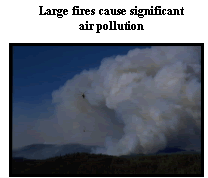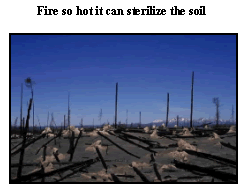Healthy Forest : An Initiative for Wildfire Prevention and Stronger Communities
The Need for Healthier Forests
Federal lands are increasingly vulnerable to catastrophic fires.
Under normal conditions of forest and rangeland health, fires play a vital
role in removing excess fuels and maintaining normal plant composition and density.
These fires tend to burn at ground level, generating low temperatures and moving
relatively slowly. When burning through forested areas, these fires remove underbrush
and dead growth while healthy, mature trees survive. Without active management
of forests and rangelands, large, expensive, and damaging wildfires will occur
more frequently, causing greater damage to people, property, and ecosystems.
Intelligent active land management that minimizes the risk of severe fires is
needed to protect forest and rangeland ecosystems.
About 190 million acres of federal forests and rangelands in the lower 48 states
face high risks of catastrophic fire due to deteriorating ecosystem health and
drought. For instance, many ponderosa pine forests are 15 times more dense than
they were a century ago. Where 25 to 35 trees once grew on each acre of forest,
now more than 500 trees are crowded together in unhealthy conditions. Drought
conditions coupled with years of fuel buildup from fire suppression and reduced
thinning make these lands vulnerable to intense and environmentally destructive
fires.
This fire season is among the worst in modern history.
More than 5.9 million acres have burned so far this year, 500,000 acres more
than the previous record-setting 2000 fire season, and more than double the
acreage of the 10-year average. Hundreds of millions of trees were destroyed
by these fires. Major fires burned in Alaska, Arizona, California, Colorado,
Georgia, Idaho, Minnesota, Montana, New Mexico, Nevada, Oregon, South Dakota,
Utah, Washington, and Wyoming.
Fires are burning with greater speed and intensity than ever before. For
example, the 468,000-acre Rodeo Fire in Arizona grew from 800 acres to 46,000
acres in just one day, destroying homes and forests owned by the White Mountain
Apache Tribe. The 137,000-acre Hayman Fire was five times bigger than the previous
largest fire in Colorado's modern history, and forced evacuations in over 80
communities. The 471,000-acre Biscuit Fire is the largest fire in Oregon's modern
history, threatening over 4,000 homes. The 147,000-acre McNally Fire threatened
sequoias along the Trail of 100 Giants in California.
Catastrophic wildfires harm people, property, and the environment.
Harm to People and Local Communities
Firefighters Are At Risk: Large, severe wildfires create unsafe conditions
for both firefighters and the public. Twenty wildland firefighters have been
killed this year. Over the last ten years, 189 wildland firefighters have been
killed, and hundreds have been injured. A national survey revealed that nearly
83 percent of all firefighters identified "fuels reduction" as the
single most important factor for improving their margin of safety on wildfires
(Wildland Firefighter Safety Awareness Study, Tri-Data, 1996).

Increased Air Pollution: Smoke from wildfires can significantly affect air
quality in neighboring cities and towns. Several Colorado communities experienced
significantly impaired air quality caused by fires for several weeks this summer;
Denver experienced the highest level of fine particulates ever
recorded in the state. The 1999 Big Bar Fire Complex in northern California
caused violations of federal and state health-based air quality standards for
22 days, and closed schools in two counties for several days.
Fires Force Thousands to Evacuate: Tens of thousands of people from 200 communities
were forced to flee wildfires this summer. In Colorado alone, more than 77,000
residents were evacuated from their homes for periods of a few days to several
weeks and the resulting damage and loss of property cost the insurance industry
more than $80 million.
Property Damage: This year more than 2,300 homes and structures were destroyed
by wildfire, causing millions of dollars in damage.
Disruption to Local Economies
Large, catastrophic fires threaten economic sustainability of communities dependent
on wildlands and natural resources. Tourism and recreational interests (such
as outfitters, guides, camping and fishing), the wood products industry, ranching,
and the service industries that support them are all affected by the loss of
resources to wildfires. Destroyed forests and damaged watersheds impose a variety
of economic costs to communities.
Reduced Tourism: In July, smoke from the Big Elk Fire reduced tourism
in Rocky Mountain National Park, depressing the local economy. In Sedona, Arizona,
occupancy rates and revenues at one popular resort hotel fell to less than half
of normal mid-summer rates.
Damage to Municipal Watersheds: Severe wildfires degrade water quality,
decrease storage capacity, and jeopardize the physical structure of municipal
watersheds. For instance, the 1996 Buffalo Creek Fire burned 12,000 acres in
Colorado's South Platte River drainage, forcing the Denver Water Board to spend
more than $20 million to address sediment problems caused by erosion into one
of Denver's primary municipal water supply reservoirs.
Environmental Damage
Severe wildfires can damage soils, water quality and quantity, fisheries, plant
communities, wildlife habitat, and endanger species. Damage to watersheds and
loss of resources may have cascading effects outside of the burned areas. For
example, fisheries can be severely impacted by sedimentation and siltation following
fires. Rehabilitation can reduce but cannot eliminate these impacts.
Damaged Fisheries: Critical trout fisheries throughout the West and
salmon and steelhead fisheries in the Pacific Northwest can suffer from increased
water temperatures, sedimentation, and changes in water quality and chemistry.
Destroyed Endangered Species Habitat: Ironically, while fuels reduction
projects are often delayed or prevented due to litigation over Endangered Species
Act requirements, catastrophic fires that could be prevented by these projects
can have devastating consequences for endangered species. For instance, the
Biscuit fire in Oregon has destroyed 125,000 to 150,000 acres of spotted owl
habitat.

Soil Sterilization: Wildfires
often require extensive site rehabilitation to protect resources and nearby
communities from floods and landslides. Topsoils exposed to extreme heat can
become water-repellant, and soil nutrients may be lost. It can take decades
or even centuries for ecosystems to recover to pre-fire conditions.
Soil Erosion: The protective covering provided by foliage and dead
organic matter is removed, leaving the soil fully exposed to wind and water
erosion. Accelerated soil erosion occurs, causing landslides and threatening
aquatic habitats.
Spread of Invasive Plant Species: Non-native woody plant species frequently
invade burned areas. When weeds become established they can dominate the
plant cover over broad landscapes, and become difficult and costly to control.
Disease and Insect Infestations: Unless diseased or insect-infested trees
are swiftly removed, infestations and disease can spread to healthy forests
and private lands. Timely active management actions are needed to remove diseased
or infested trees.
[
Table of Contents |
Next Chapter ]





